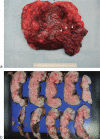A Case Report and Literature Review of Midtrimester Termination of Pregnancy Complicated by Placenta Previa and Placenta Accreta
- PMID: 26199801
- PMCID: PMC4502619
- DOI: 10.1055/s-0034-1395992
A Case Report and Literature Review of Midtrimester Termination of Pregnancy Complicated by Placenta Previa and Placenta Accreta
Abstract
Objective Concurrent placenta previa and placenta accreta increase the risk of massive obstetric hemorrhage. Despite extensive research on the management of placenta previa (including placenta accreta, increta, and percreta), the number and quality of previous studies are limited. We present a case of placenta accreta requiring an induced second-trimester abortion because of premature rupture of the membranes (PROM). Study Design Case report and review of the literature. Results A 41-year-old female presented at 20 weeks of gestation with placenta previa and PROM. Ultrasonography revealed placenta accreta with multiple placental lacunae. She then developed massive hemorrhaging just prior to a planned termination of pregnancy. We performed a hysterectomy with the intent of preserving life because of the failure of the placenta to detach and blood loss totaling 4,500 mL. Conclusion Previous studies suggest that second-trimester pregnancy terminations in cases of placenta previa which are not complicated with placenta accreta do not have a particularly high risk of hemorrhage. However, together with our case, the literature suggests that placenta previa complicated with placenta accreta presents a significant risk of hemorrhage both during delivery and intraoperatively. Further reports are needed to evaluate the most appropriate treatment options.
Keywords: cesarean hysterectomy; midtrimester termination; placenta accreta; placenta previa.
Conflict of interest statement
Figures


Similar articles
-
Clinical analysis of second-trimester pregnancy termination after previous caesarean delivery in 51 patients with placenta previa and placenta accreta spectrum: a retrospective study.BMC Pregnancy Childbirth. 2021 Aug 18;21(1):568. doi: 10.1186/s12884-021-04017-8. BMC Pregnancy Childbirth. 2021. PMID: 34407784 Free PMC article.
-
Fluid resuscitation strategy in patients with placenta previa accreta: a retrospective study.Front Med (Lausanne). 2024 Sep 24;11:1454067. doi: 10.3389/fmed.2024.1454067. eCollection 2024. Front Med (Lausanne). 2024. PMID: 39380734 Free PMC article.
-
Placenta previa, placenta accreta, and vasa previa.Obstet Gynecol. 2006 Apr;107(4):927-41. doi: 10.1097/01.AOG.0000207559.15715.98. Obstet Gynecol. 2006. PMID: 16582134 Review.
-
Placenta previa increta/percreta in Japan: a retrospective study of ultrasound findings, management and clinical course.J Obstet Gynaecol Res. 2007 Oct;33(5):606-11. doi: 10.1111/j.1447-0756.2007.00619.x. J Obstet Gynaecol Res. 2007. PMID: 17845316
-
Placenta accreta spectrum: accreta, increta, and percreta.Obstet Gynecol Clin North Am. 2015 Jun;42(2):381-402. doi: 10.1016/j.ogc.2015.01.014. Obstet Gynecol Clin North Am. 2015. PMID: 26002174 Review.
Cited by
-
Obstetric Outcomes of Pregnancy After Uterine Artery Embolization.Int J Womens Health. 2020 Mar 6;12:151-158. doi: 10.2147/IJWH.S236443. eCollection 2020. Int J Womens Health. 2020. PMID: 32184677 Free PMC article.
-
Clinical analysis of second-trimester pregnancy termination after previous caesarean delivery in 51 patients with placenta previa and placenta accreta spectrum: a retrospective study.BMC Pregnancy Childbirth. 2021 Aug 18;21(1):568. doi: 10.1186/s12884-021-04017-8. BMC Pregnancy Childbirth. 2021. PMID: 34407784 Free PMC article.
-
Maternal and Fetal Outcomes after Prior Mid-Trimester Uterine Rupture: A Systematic Review with Our Experience.Medicina (Kaunas). 2021 Nov 24;57(12):1294. doi: 10.3390/medicina57121294. Medicina (Kaunas). 2021. PMID: 34946239 Free PMC article.
-
Surgical Outcomes and Associated Morbidity of Active and Expectant Management of Second-Trimester Placenta Accreta Spectrum (PAS).Medicina (Kaunas). 2025 Jan 14;61(1):113. doi: 10.3390/medicina61010113. Medicina (Kaunas). 2025. PMID: 39859095 Free PMC article.
-
Systematic review on the needle and suture types for uterine compression sutures: a literature review.BMC Surg. 2019 Dec 16;19(1):196. doi: 10.1186/s12893-019-0660-z. BMC Surg. 2019. PMID: 31842850 Free PMC article.
References
-
- Silver R M, Landon M B, Rouse D J. et al.Maternal morbidity associated with multiple repeat cesarean deliveries. Obstet Gynecol. 2006;107(6):1226–1232. - PubMed
-
- Oyelese Y, Smulian J C. Placenta previa, placenta accreta, and vasa previa. Obstet Gynecol. 2006;107(4):927–941. - PubMed
-
- Rao K P, Belogolovkin V, Yankowitz J, Spinnato J A II. Abnormal placentation: evidence-based diagnosis and management of placenta previa, placenta accreta, and vasa previa. Obstet Gynecol Surv. 2012;67(8):503–519. - PubMed
-
- Robinson B K, Grobman W A. Effectiveness of timing strategies for delivery of individuals with placenta previa and accreta. Obstet Gynecol. 2010;116(4):835–842. - PubMed
-
- Matsuzaki S, Yoshino K, Kajimoto E. et al.Successful management of placenta percreta by cesarean hysterectomy with transverse uterine fundal incision. Int J Reprod Contracept Obstet Gynecol. 2014;3(2):447–449.
Publication types
LinkOut - more resources
Full Text Sources
Other Literature Sources

